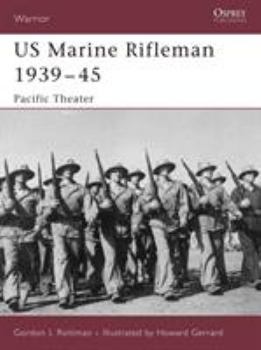US Marine Rifleman 1939–45: Pacific Theater
(Book #112 in the Osprey Warrior Series)
Osprey's study of United States Marine Corps riflemen during World War II (1939-1945). It is sometimes a basic assumption that a US Marine Corps rifleman was essentially trained, uniformed, equipped, and armed much the same as a US Army rifleman during World War II. While there were of course similarities, the Marines conducted their own unique training programs, wore mostly different uniforms and equipment, and possessed some unique weapons, although they also used many of the same weapons as the Army. The Marine Corps was not part of the Navy, but a component of the Navy Department alongside the Navy. While the Marines specialized in amphibious warfare, the Army actually conducted more amphibious assaults in the Pacific than the Marines. The typical Marine was extremely proud of his service and acutely aware that there were only six Marine divisions but 89 Army divisions. The Marine Corps began World War II with less than 66,000 officers and men; more than that would be wounded before it ended. The Corps grew to almost 487,000. It provided only 5 percent of the US armed forces, but suffered 10 percent of overall American casualties. The Marines were able to build on their proud traditions and history to transform a small branch of service into a premier combined arms amphibious assault force. Regardless of its expansion by 750 percent, the Corps was able to maintain its sense of tradition, instill that into thousands of new Marines, and create an elite arm of service. Here, Gordon L Rottman, follows the Marine rifleman through his draft and training, and then participation in operations such as Roi-Namur in the Marshall Islands, Saipan and Tinian in the Mariana Islands, and Iwo Jima. The opening sentences of the Marine Creed, composed shortly after the attack on Pearl Harbor This is my rifle. There are many like it, but this one is mine. It is my life. I must master it as I must master my life. Without me my rifle is useless. Without my rifle, I am useless.
Format:Paperback
Language:English
ISBN:184176972X
ISBN13:9781841769721
Release Date:November 2006
Publisher:Osprey Publishing (UK)
Length:64 Pages
Weight:0.05 lbs.
Dimensions:0.3" x 7.2" x 9.8"
Customer Reviews
1 rating
Private's view-point
Published by Thriftbooks.com User , 17 years ago
What was it like to be one of the half-million Marines in service from 1939 to 1945? Gordon L. Rottman tells all in a slim, 64-page book packed with vintage photographs and eight pages of color drawings by Howard Gerrard. Rottman orients the reader with a chronology, then writes about conscription and how it affected the Corps. When I was a Marine recruit at MCRD San Diego in June thorugh September 1975, I was told that Marines were all volunteers, that none were drafted. Rottman gave a good account of how the Marine Corps claim of "no draftees" and the US law that ended voluntary enlistments on December 5, 1942 were reconciled: Selective Service Volunteers! The Blue Star program was mentioned. Then Rottman got into the subjects that were my reason for buying his book: * Training * Appearance * Equipment * Belief and belonging * Camp Pendleton * Conditions of service * On campaign * The aftermath of battle * collections, museum,s and reenactments The color plate section shows the naval service identity disks (dog tags), the Marine's Handbook, C and K rations, the contents of the first aid kit and toilet articles. Rottman condensed the experience of being a World War Two Marine into a short, easy to digest book. Infantry combat is a team sport, not individual competition--and Rottman begins by taking the reader through basic. Today, a minimum of 16 weeks of combat training is required before committing a new Marine to combat--but in the early scramble to build up the Corps, boot camp was shortened to three weeks. By 1944, basic training in either San Diego, California, or Parris Island, South Carolina, was officially eight weeks. Basic training was (and still is) all about making team players. After basic training, the newly-minted private is then assigned to his new squad and has to train all over again so that the 13 Marines can function as a single organism. At the beginning of the war, peacetime rifle strength was eight Marines, usually all armed with the M1903A1 Springfield rifle. On paper, there was supposed to be an automatic rifle in the squad. The Marine rifle squad was commanded by a corporal and was organized the same as an Army rifle squad. Wartime strength was supposed to be 12 men in both services. By 1944, the Marines had found a better way to organize the squad, one that is still used today. A sergeant commanded three corporal fire team leaders. Each fire team was built around an automatic rifle, which provided the bulk of the fire team's killing power, along with hand and rifle grenades--though officially the M1 Garand semi-automatic rifle was the rifle squad's major weapon system. The rest of the squad was armed with a mix of M1 carbines, M1 rifles, the occassional Thompson submachine gun or Springfield rifle, perhaps the new M3 "grease gun" submachine gun, demolitions, grenades, K-bar jungle knives, bayonets, and sometimes a pistol or two. Battle experience found that a small group could survive and fight b





